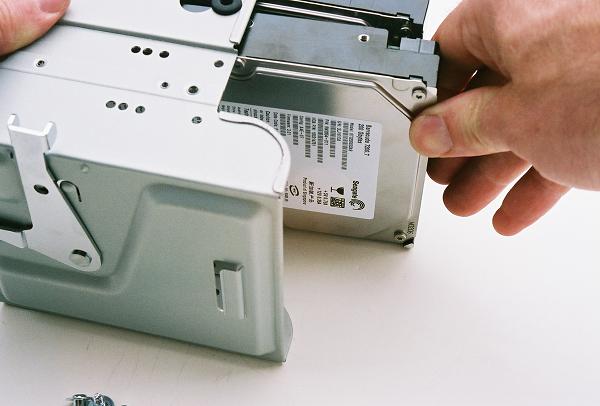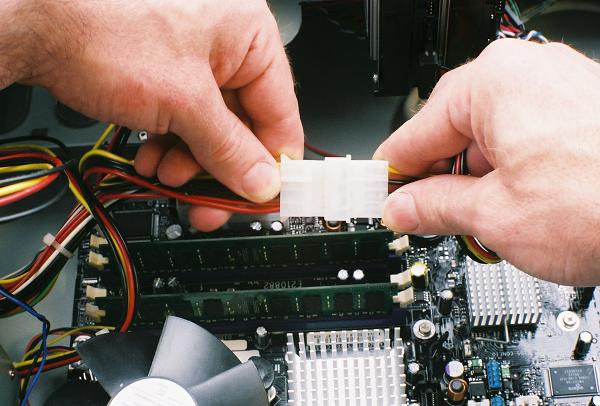
- Step 1: Preparing the case
- Step 2: Installing the CPU
- Step 3: Installing RAM
- Step 4: Installing the Motherboard
- Step 5: Making Motherboard Connections
- Step 6: Installing an SATA two drive array
- Step 7: Installing Adapters, Nvidia GeForce PCI Express
- Step 8: Finishing the hard drive array
- Step 9: Installing the DVD recorder
- Step 10: Closing up and CMOS Setup
Copyright 2018 by Morris Rosenthal
All Rights Reserve
Build Your Own PC - Step 6: Installing an SATA two drive array
We assemble and install our two drive SATA array at this point for the simple reason that the drive cage can't be removed once the PCI Express video adapter is installed. The 3.5" drive cage is supported and secured by metal guides and a locking lever. The locking lever is pushed towards the inside of the case, and the whole cage slides out horizontally with very little resistance.
Figure 39: Removing the 3.5" drive cage

We'll be installing two 3.5" Seagate Barracuda SATA high performance hard drives. There are two bays in the cage equipped with shock absorbing rubber mounts, which help protect the hard drives from vibrations in the case. In order to use the bays with the shock absorbing mounts, the drives can only be installed in an upside-up orientation; the screw holes won't line up any other way.
Figure 40: Installing the first Seagate Barracuda drive in the cage

The drive is secured with four special screws that were supplied with the case hardware. Over tightening the screws would simply crush the rubber mounts, so don't run the screws in with all your strength. One of the screws with its unthreaded upper shaft is shown sitting on the side of the hard drive to the left of the screwdriver.
Figure 41: Securing the hard drive

The second hard drive is installed in the cage right above the first. The advantage of the removable drive cage is that the drives can be aligned and secured with screws on both sides without having to access the other side of the case. The top two bays in the cage could be used for a floppy drive and another 3.5" drive, but we won't be installing either in this build.
Figure 42: Installing the second Seagate Barracuda hard drive

With both drives installed in the shock absorbing bays of the drive cage, you can see that there's a small air space between them. The drives do not touch each other. A tower case, like that used in our Chapter 6 build, has multiple removable drive cages that allow for greater drive spacing.
Figure 43: Securing the second drive with four screws

The drive cage is reinstalled in the case infrastructure by sliding it in on the horizontal. This means there must be an open space in the case as deep as the length of the hard drives, which is why we had to install the drives before the video adapter.
Figure 44: Sliding the cage into the case infrastructure

While the drive cage is supported in the vertical plane by the case infrastructure as soon as it's slid into place, it will still slide in the horizontal until you close the locking lever. The lever should operate with very little resistance, if it seems to be bound, remove the cage again and make sure it actually slid in properly on the guides.
Figure 45: Locking the drive cage into place

Next we install our SATA power connectors on the drives. This is another step that we are taking now simply because it would be very difficult to carry it out once the video adapter is installed. The two SATA power connectors are fit on the smaller edge connectors of the hard drive, and they are keyed so they can only be installed in the proper orientation.
Figure 46: Installing the SATA power connectors

New power supplies all ship with SATA power connectors as standard option, but at the time we built this system, power supplies required a simple adapter. In this case, we used an SATA power adapter, two connectors located on a 4 wire cable bundle, which is then connected to a standard 1x4 connector from the power supply.
Figure 47: Connecting the SATA power adapter to a power supply lead

Proceed to Step 7: Installing Adapters, Nvidia GeForce PCI Express